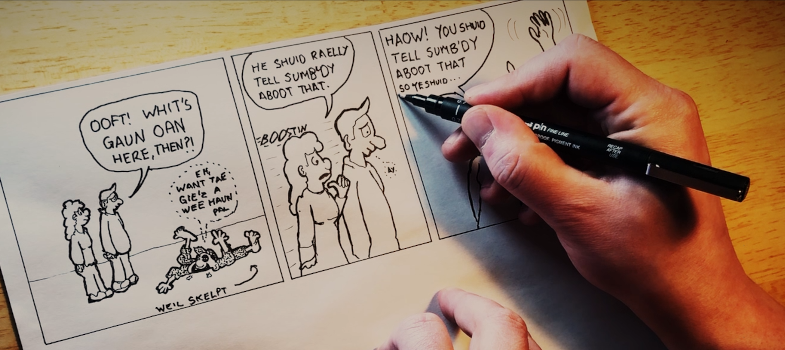Scots Language Teacher CPD – Course Guide
3. Unit Structure
Unit 1 is an introductory unit and depending on your previous knowledge and skills you can study it in full or parts of it only.
Units 2 to 7 have the same elements and structure. They are all structured as follows.
1: Introduction
Here you find out about the theme of the unit, the reason why it is important to study this and the key learning objectives of each unit.
2: Input
Here you study some core stimuli to instigate your thinking about the theme of the unit. You will be asked to reflect on aspects of the stimuli and can compare your reflections with the model answers provided. You should also be prepared to discuss aspects of the stimuli further in the tutorial.
3: Tutorial
Here you’ll have the opportunity to engage in deeper discussion inspired by the input stimuli. A central aspect of your tutorial will be an introduction to the class-based application task and an opportunity to start planning for and discussing approaches to the Application element together with your peers.
4: Application and reflection
This takes place in your classroom, with your learners. You will try out the task you started designing during the Tutorial and completed afterwards. Part of the Application task is to reflect on the challenges and successes of your planned activity with your fellow students in the unit discussion forum.
Note: you will have to successfully complete at least five out of the Application tasks from Units 2 to 7 in order to pass the course. The five tasks you complete will need to include Application task 7. See the assessment section for further information.
5: Community link
This contains information on an existing community-based Scots language initiative. This element provides an idea of the types of opportunity that already exist and may inspire thoughts for collaboration with these or other community groups with an interest in Scots language (learning). The aim is to highlight how you can take language learning beyond your own classroom and link up with others in the Scots language community. You will be encouraged to share ideas and links to other initiatives using the Twitter hashtag for this module – #OU_ScotsCPD – which will also help you establish a community of practice with your peers in this medium that is open to you beyond this course.
6: Research on Scots
Engaging with the content of this section supports you in fulfilling the Masters level study criteria of this course. You engage with examples of research on teaching Scots in the school classroom as well as the important role of Scots as a non-standard indigenous language within the educational context. What you study here will feed into the work you do towards the Professional Recognition award for this course.
7: Professional Recognition reflective task
This section involves a reflective task and is an element required for the award of Professional Recognition in Teaching Scots Across the Curriculum from the General Teaching Council for Scotland. The reflective task consists of a blog post in response to the peer discussion around the application task for each unit. For Units 2–6 the length of the post ranges from 300 to 750 words. For Unit 7 the reflective task is a blog post of 750-1000 words in which students consider the impact of the course as a whole on the development of their practice in teaching Scots in their classrooms.
Note: you will have to successfully complete at least five out of the Professional Recognition reflective tasks from Units 2 to 7 in order to pass the course. The five tasks you complete will need to include the Professional recognition task in Unit 7. See the assessment section for further information.
8: Further Engagement
This includes suggestions for further related academic and other reading, practice or learning that you may wish to undertake to deepen your understanding and knowledge of the theme of the unit.
